Genetic and Phenotypic Characterization of Botrytis Populations from Economic and Wild Host Plants in Iran
Abstract
1. Introduction
2. Materials and Methods
2.1. Fungal Isolates
2.2. Genetic Analysis and Fungicide Resistance
2.3. Phylogenetic Analysis
2.4. Pathogenicity Assay
3. Results
3.1. Fungal Isolates
3.2. Grouping of Isolates Based on Genetic Analyses and Fungicide Resistance
3.3. Phylogenetic Analysis
3.4. Morphological Analysis and Fungicide Resistance and Pathogenicity
4. Discussion
Supplementary Materials
Author Contributions
Funding
Institutional Review Board Statement
Data Availability Statement
Acknowledgments
Conflicts of Interest
References
- FAOSTAT. Food and Agriculture Organization. The Database of Annual Production. FAOSTAT. Statistical Database. 2019. Available online: https://www.fao.org/faostat/en/#data/QC (accessed on 30 July 2024).
- Nabizadeh, H.; Ahmadpour, A.; Gosta, Y. Study on the diversity of Botrytis spp. from different plants in West Azarbaijan province and Sanadaj city (Kurdistan province). Iran. J. Plant Pathol. 2022, 57, 237–262. [Google Scholar]
- Kulkarni, S.J. An insight into research and investigations of gray mold focused on Botrytis cinerea. In Driving Factors for Venture Creation and Success in Agricultural Entrepreneurship; Arafat, M.Y., Saleem, I., Ali, J., Khan, A., Balhareth, H.H., Eds.; IGI Global: Hershey, PA, USA, 2022; pp. 273–289. [Google Scholar]
- Gül, E.; Karakaya, A.; Ergül, A. Determination of the frequency and virulence of some Botrytis cinerea isolates and a new Botrytis prunorum cryptic species causing grey mould disease on greenhouse tomatoes. Plant Pathol. 2023, 72, 1226–1235. [Google Scholar] [CrossRef]
- Maia, J.N.; Beger, G.; Pereira, W.V.; De Mio, L.L.M.; Duarte, H.D.S.S. Gray mold in strawberries in the Paraná state of Brazil is caused by Botrytis cinerea and its isolates exhibit multiple-fungicide resistance. Crop Prot. 2021, 140, 105415. [Google Scholar] [CrossRef]
- Fekrikohan, S.; Atashi Khalilabad, A.; Fotouhifar, K.; Sharifnabi, B. First report of Botrytis cinerea and Alternaria alternata on Pelargonium grandiflorum in Iran. Mycol. Iran. 2022, 9, 105–115. [Google Scholar]
- Naeimi, S.; Zare, R. Evaluation of indigenous Trichoderma spp. isolates in biological control of Botrytis cinerea, the causal agent of strawberry gray mold disease. Biocontrol Plant Prot. 2013, 1, 55–74. [Google Scholar]
- Garfinkel, A.R.; Coats, K.P.; Sherry, D.L.; Chastagner, G.A. Genetic analysis reveals unprecedented diversity of a globally-important plant pathogenic genus. Sci. Rep. 2019, 9, 6671. [Google Scholar] [CrossRef] [PubMed]
- Garfinkel, A.R. The history of Botrytis taxonomy, the rise of phylogenetics, and implications for species recognition. Phytopathology 2021, 111, 437–454. [Google Scholar] [CrossRef] [PubMed]
- Ziedan, E.H.; Attallah, A.G.; Abd-El-Aal, S.K.; Sahab, A.F. Molecular identification and pathogenic potential of Botrytis cinerea isolates causing fruit blight of cucumber under protective greenhouse in Egypt. Plant Arch. 2018, 18, 1563–1569. [Google Scholar]
- Dean, R.; Van Kan, J.A.; Pretorius, Z.A.; Hammond-Kosack, K.E.; Di Pietro, A.; Spanu, P.D.; Rudd, J.J.; Dickman, M.; Khahmann, R.; Ellis, J.; et al. The Top 10 fungal pathogens in molecular plant pathology. Mol. Plant Pathol. 2012, 13, 414–430. [Google Scholar] [CrossRef]
- Giraud, T.; Fortini, D.; Levis, C.; Lamarque, C.; Leroux, P.; Lobuglio, K.; Brygoo, Y. Two sibling species of the Botrytis cinerea complex, transposa and vacuma, are found in sympatry on numerous host plants. Phytopathology 1999, 89, 967–973. [Google Scholar] [CrossRef]
- Giraud, T.; Fortini, D.; Levis, C.; Leroux, P.; Brygoo, Y. RFLP markers show genetic recombination in Botryotinia fuckeliana (Botrytis cinerea) and transposable elements reveal two sympatric species. Mol. Biol. Evol. 1997, 14, 1177–1185. [Google Scholar] [CrossRef] [PubMed]
- Wessels, B.; Linde, C.; Fourie, P.; Mostert, L. Genetic population structure and fungicide resistance of Botrytis cinerea in pear orchards in the Western Cape of South Africa. Plant Pathol. 2016, 65, 1473–1483. [Google Scholar] [CrossRef]
- De Miccolis Angelini, R.M.; Rotolo, C.; Masiello, M.; Pollastro, S.; Ishii, H.; Faretra, F. Genetic analysis and molecular characterisation of laboratory and field mutants of Botryotinia fuckeliana (Botrytis cinerea) resistant to QoI fungicides. Pest Manag. Sci. 2012, 68, 1231–1240. [Google Scholar] [CrossRef] [PubMed]
- Staats, M.; van Baarlen, P.; Van Kan, J.A. Molecular phylogeny of the plant pathogenic genus Botrytis and the evolution of host specificity. Mol. Biol. Evol. 2005, 22, 333–346. [Google Scholar] [CrossRef] [PubMed]
- Staats, M.; Van Baarlen, P.; Schouten, A.; Van Kan, J.A. Functional analysis of NLP genes from Botrytis elliptica. Mol. Plant Pathol. 2007, 8, 209–214. [Google Scholar] [CrossRef]
- Zhang, J.; Zhang, L.; Li, G.Q.; Yang, L.; Jiang, D.H.; Zhuang, W.Y.; Huang, H.C. Botrytis sinoallii: A new species of the grey mould pathogen on Allium crops in China. Mycoscience 2010, 51, 421–431. [Google Scholar] [CrossRef]
- Zhou, Y.J.; Zhang, J.; Wang, X.D.; Yng, L.; Jiang, D.H.; Li, G.Q.; Hsiang, T.; Zhuang, W.Y. Morphological and phylogenetic identification of Botrytis sinoviticola, a novel cryptic species causing gray mold disease of table grapes (Vitis vinifera) in China. Mycologia 2014, 106, 43–56. [Google Scholar] [CrossRef]
- Liu, Q.; Li, G.; Li, J.; Chen, S. Botrytis eucalypti, a novel species isolated from diseased Eucalyptus seedlings in South China. Mycol. Prog. 2016, 15, 1057–1079. [Google Scholar] [CrossRef]
- Leroch, M.; Plesken, C.; Weber, R.W.; Kauff, F.; Scalliet, G.; Hahn, M. Gray mold populations in German strawberry fields are resistant to multiple fungicides and dominated by a novel clade closely related to Botrytis cinerea. Appl. Environ. Microbiol. 2013, 79, 159–167. [Google Scholar] [CrossRef]
- De Miccolis Angelini, R.M.; Habib, W.; Rotolo, C.; Pollastro, S.; Faretra, F. Selection, characterization and genetic analysis of laboratory mutants of Botryotinia fuckeliana (Botrytis cinerea) resistant to the fungicide boscalid. Eur. J. Plant Pathol. 2010, 128, 185–199. [Google Scholar] [CrossRef]
- Ma, Z.; Michailides, T.J. Genetic structure of Botrytis cinerea populations from different host plants in California. Plant Dis. 2005, 89, 1083–1089. [Google Scholar] [CrossRef] [PubMed]
- Habib, W.; De Miccolis Angelini, R.M.; Rotolo, C.; Pollastro, S.; Faretra, F. Genetic variation in Botryotinia fuckeliana (Botrytis cinerea) populations on greenhouse vegetable crops in Lebanon. In Proceedings of the Abstract Book of XVIth International Botrytis Symposium, Bari, Italy, 23–28 June 2013; p. 37. [Google Scholar]
- Fournier, E.; Levis, C.; Fortini, D.; Leroux, P.; Giraud, T.; Brygoo, Y. Characterization of Bc-hch, the Botrytis cinerea homolog of the Neurospora crassa het-c vegetative incompatibility locus, and its use as a population marker. Mycologia 2003, 95, 251–261. [Google Scholar] [CrossRef]
- De Miccolis Angelini, R.M.; Rotolo, C.; Masiello, M.; Gerin, D.; Pollastro, S.; Faretra, F. Occurrence of fungicide resistance in populations of Botryotinia fuckeliana (Botrytis cinerea) on table grape and strawberry in southern Italy. Pest Manag. Sci. 2014, 70, 1785–1796. [Google Scholar] [CrossRef]
- Eyvazi, A.; Massah, A.; Soorni, A.; Babaie, G. Molecular phylogenetic analysis shows that causal agent of maize rough dwarf disease in Iran is closer to rice black-streaked dwarf virus. Eur. J. Plant Pathol. 2021, 160, 411–425. [Google Scholar] [CrossRef]
- Kumar, S.; Stecher, G.; Tamura, K. MEGA7: Molecular Evolutionary Genetics Analysis Version 7.0 for bigger datasets. Mol. Biol Evol. 2016, 33, 1870–1874. [Google Scholar] [CrossRef]
- Rasiukevičiūtė, N.; Rugienius, R.; Šikšnianienė, J.B. Genetic diversity of Botrytis cinerea from strawberry in Lithuania. Zemdirbyste 2018, 105, 265–270. [Google Scholar] [CrossRef]
- Johnston, P.R.; Hoksbergen, K.; Park, D.; Beever, R.E. Genetic diversity of Botrytis in New Zealand vineyards and the signi–ficance of its seasonal and regional variation. Plant Pathol. 2014, 63, 888–898. [Google Scholar] [CrossRef]
- Mirzaei, S.; Goltapeh, E.M.; Shams-bakhsh, M. Taxonomical studies on the genus Botrytis in Iran. J. Agric. Technol. 2007, 3, 65–76. [Google Scholar]
- Ferrada, E.E.; Latorre, B.A.; Zoffoli, J.P.; Castillo, A. Identification and characterization of Botrytis blossom blight of Japanese plums caused by Botrytis cinerea and B. prunorum sp. nov. in Chile. Phytopathology 2016, 106, 155–165. [Google Scholar] [CrossRef]
- Schumacher, J. How light affects the life of Botrytis. Fungal Genet. Biol. 2017, 106, 26–41. [Google Scholar] [CrossRef]
- Amiri, A.; Zuniga, A.I.; Peres, N.A. Prevalence of Botrytis cryptic species in strawberry nursery transplants and strawberry and blueberry commercial fields in the eastern United States. Plant Dis. 2018, 102, 398–404. [Google Scholar] [CrossRef] [PubMed]
- Isaza, L.; Zuluaga, Y.P.; Marulanda, M.L. Morphological, pathogenic and genetic diversity of Botrytis cinerea Pers. in blackberry cultivations in Colombia. Rev. Bras. Frutic. 2019, 41, 115. [Google Scholar] [CrossRef]
- Nielsen, K.A.; Skårn, M.N.; Strømeng, G.M.; Brurberg, M.B.; Stensvand, A. Pervasive fungicide resistance in Botrytis from strawberry in Norway: Identification of the grey mould pathogen and mutations. Plant Pathol. 2022, 71, 1392–1403. [Google Scholar] [CrossRef]
- Testempasis, S.; Puckett, R.D.; Michailides, T.J.; Karaoglanidis, G.S. Genetic structure and fungicide resistance profile of Botrytis spp. populations causing postharvest gray mold of pomegranate fruit in Greece and California. Postharvest Biol. Technol. 2020, 170, 111319. [Google Scholar] [CrossRef]
- Saito, S.; Margosan, D.; Michailides, T.J.; Xiao, C.L. Botrytis californica, a new cryptic species in the B. cinerea species complex causing gray mold in blueberries and table grapes. Mycologia 2016, 108, 330–343. [Google Scholar] [CrossRef]
- Esterio, M.; Osorio-Navarro, C.; Carreras, C.; Azócar, M.; Copier, C.; Estrada, V.; Auger, J. Botrytis prunorum associated to Vitis vinifera blossom blight in Chile. Plant Dis. 2020, 104, 2324–2329. [Google Scholar] [CrossRef]
- Riquelme, D.; Aravena, Z.; Valdés-Gómez, H.; Latorre, B.A.; Díaz, G.A.; Zoffoli, J.P. Characterization of Botrytis cinerea and B. prunorum from healthy floral structures and decayed ‘Hayward’ kiwifruit during post-harvest storage. Plant Dis. 2021, 105, 2129–2140. [Google Scholar] [CrossRef]
- Acosta Morel, W.; Marques-Costa, T.M.; Santander-Gordón, D.; Anta Fernández, F.; Zabalgogeazcoa, I.; Vázquez de Aldana, B.R.; Sukno, S.A.; Díaz-Mínguez, J.M.; Benito, E.P. Physiological and population genetic analysis of Botrytis field isolates from vineyards in Castilla y León, Spain. Plant Pathol. 2019, 68, 523–536. [Google Scholar] [CrossRef]
- Moparthi, S.; Parikh, L.P.; Gunnink Troth, E.E.; Burrows, M.E. Identification and prevalence of seedborne Botrytis spp. in dry pea, lentil, and chickpea in Montana. Plant Dis. 2023, 107, 382392. [Google Scholar] [CrossRef]
- Walker, A.S.; Gautier, A.; Confais, J.; Martinho, D.; Viaud, M.; Le P Cheur, P.; Dupont, J.; Fournier, E. Botrytis pseudocinerea, a new cryptic species causing gray mold in French vineyards in sympatry with Botrytis cinerea. Phytopathology 2011, 101, 1433–1445. [Google Scholar] [CrossRef]
- Plesken, C.; Westrich, L.D.; Hahn, M. Genetic and phenotypic characterization of Botrytis calthae. Plant Pathol. 2015, 64, 128–136. [Google Scholar] [CrossRef]
- Sadeghi, A.; Atghia, O.; Javan-Nikkhah, M. Occurrence of Botrytis sinoviticola on pomegranate fruit. In Proceedings of the 23rd Iranian Plant Protection Congress, Gorgan University of Agricultural Sciences and Natural Resources, Gorgan, Iran, 27–30 August 2018; pp. 440–441. [Google Scholar]
- Garfinkel, A.R.; Lorenzini, M.; Zapparoli, G.; Chastagner, G.A. Botrytis euroamericana, a new species from peony and grape in North America and Europe. Mycologia 2017, 109, 495–507. [Google Scholar] [CrossRef]
- Zhang, M.; Wu, H.Y.; Wang, X.J.; Sun, B. First report of Botrytis cinerea causing fruit rot of Pyrus sinkiangensis in China. Plant Dis. 2014, 98, 281. [Google Scholar] [CrossRef]
- Garfinkel, A.R.; Coats, K.P.; Chastagner, G.A. Identification of Botrytis paeoniae microsatellites using Ion Proton technology. In Proceedings of the XII International Symposium on Flower Bulbs and Herbaceous Perennials, Kunming, China, 28 June–2 July 2016; pp. 341–348. [Google Scholar]
- Chen, X.R.; Huang, S.X.; Wang, H.; Zhang, Y.; Ji, Z.L. First report of Botrytis cinerea causing leaf spot of Chinese quince in China. Plant Dis. 2019, 103, 1027. [Google Scholar] [CrossRef]
- Harper, L.A.; Derbyshire, M.C.; Lopez-Ruiz, F.J. Identification and characterization of Botrytis medusae, a novel cryptic species causing grey mould on wine grapes in Australia. Plant Pathol. 2019, 68, 939–953. [Google Scholar] [CrossRef]
- Brauna-Morževska, E.; Stoddard, F.L.; Bankina, B.; Kaņeps, J.; Bimšteine, G.; Petrova, I.; Fridmanis, D. Evaluation of pathogenicity of Botrytis species isolated from different legumes. Front. Plant Sci. 2023, 14, 1069126. [Google Scholar] [CrossRef]
- Rupp, S.; Weber, R.W.; Rieger, D.; Detzel, P.; Hahn, M. Spread of Botrytis cinerea strains with multiple fungicide resistance in German horticulture. Front. Microbiol. 2017, 7, 2075. [Google Scholar] [CrossRef]
- Lorenzini, M.; Zapparoli, G. An isolate morphologically and phylogenetically distinct from Botrytis cinerea obtained from withered grapes possibly represents a new species of Botrytis. Plant pathol. 2014, 63, 1326–1335. [Google Scholar] [CrossRef]
- Van Kan, J.A.; Stassen, J.H.; Mosbach, A.; Van Der Lee, T.A.; Faino, L.; Farmer, A.D.; Papasotiriou, D.G.; Zhou, S.; Seidl, M.F.; Cottam, E.; et al. A gapless genome sequence of the fungus Botrytis cinerea. Mol. Plant Pathol. 2017, 18, 75–89. [Google Scholar] [CrossRef]
- Prasannath, K.; Galea, V.J.; Akinsanmi, O.A. Diversity and pathogenicity of species of Botrytis, Cladosporium, Neopestalotiopsis and Pestalotiopsis causing flower diseases of macadamia in Australia. Plant Pathol. 2023, 72, 881–899. [Google Scholar] [CrossRef]
- Amselem, J.; Cuomo, C.A.; van Kan, J.A.; Viaud, M.; Benito, E.P.; Couloux, A.; Dickman, M. Genomic analysis of the necrotrophic fungal pathogens Sclerotinia sclerotiorum and Botrytis cinerea. PLoS Genet. 2011, 7, e1002230. [Google Scholar] [CrossRef] [PubMed]
- Marin, M.V.; Peres, N.A. First Report of Botrytis cinerea causing leaf spot on strawberry in Florida. Plant Dis. 2022, 106, 1298. [Google Scholar] [CrossRef] [PubMed]

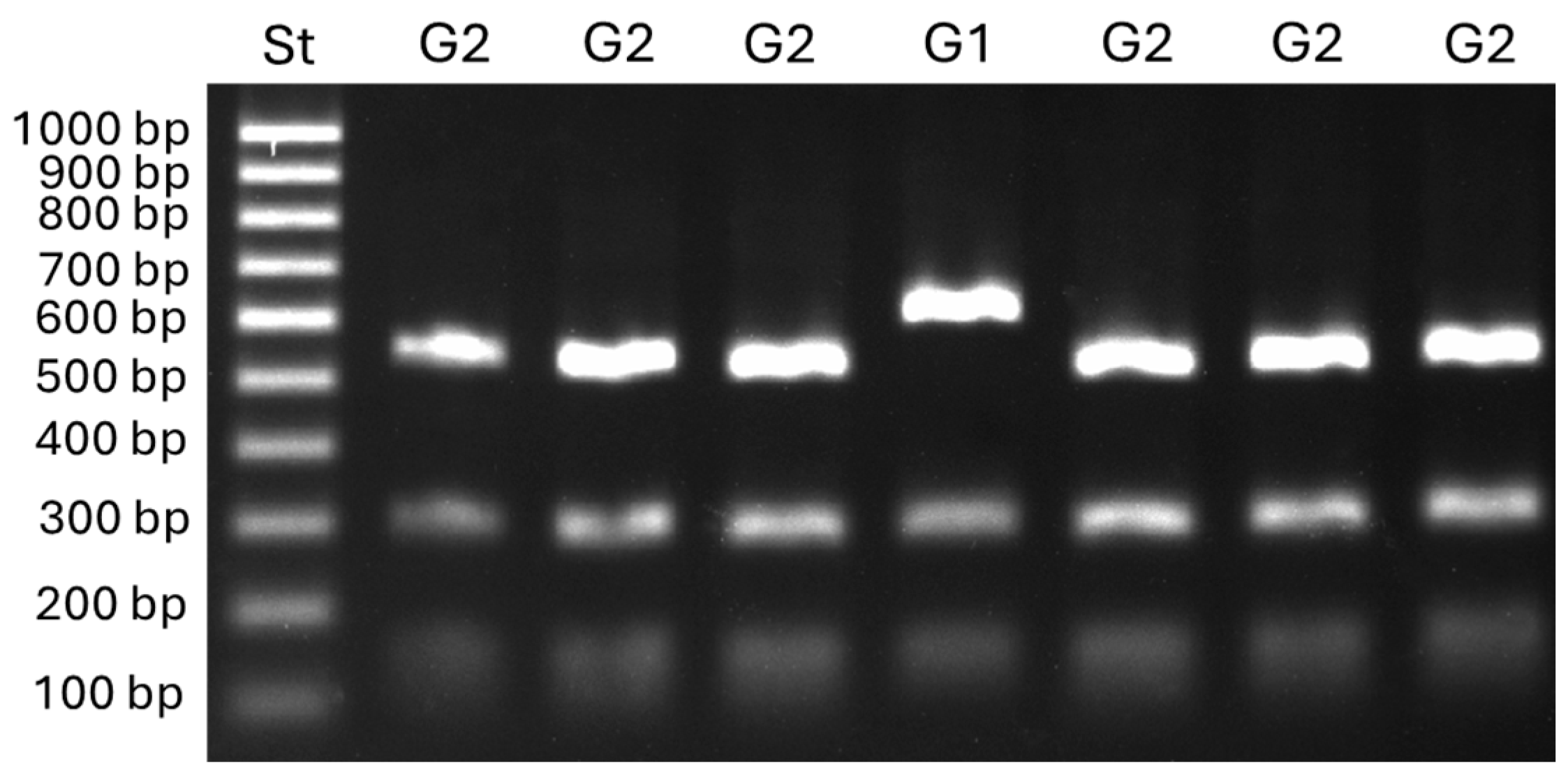

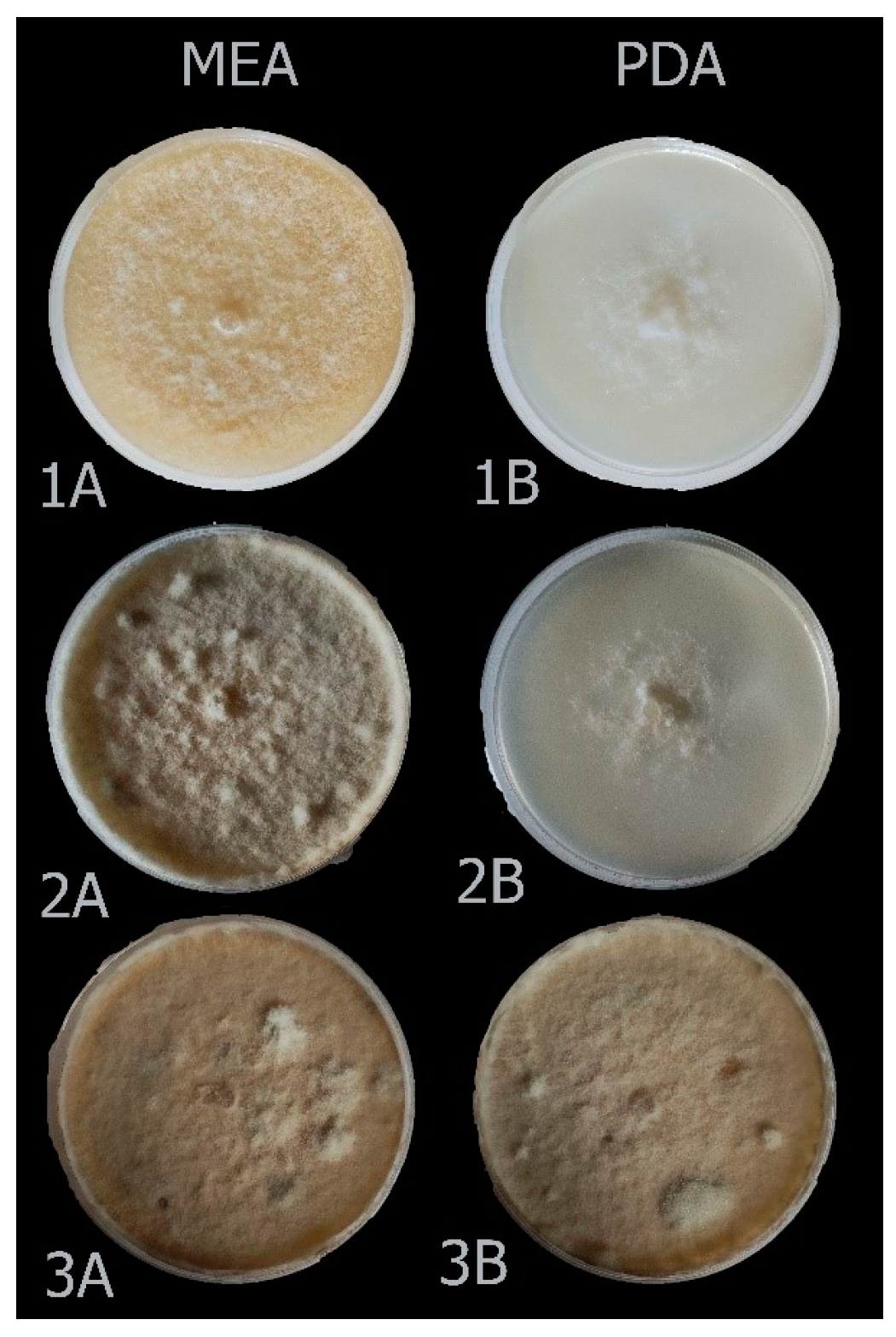
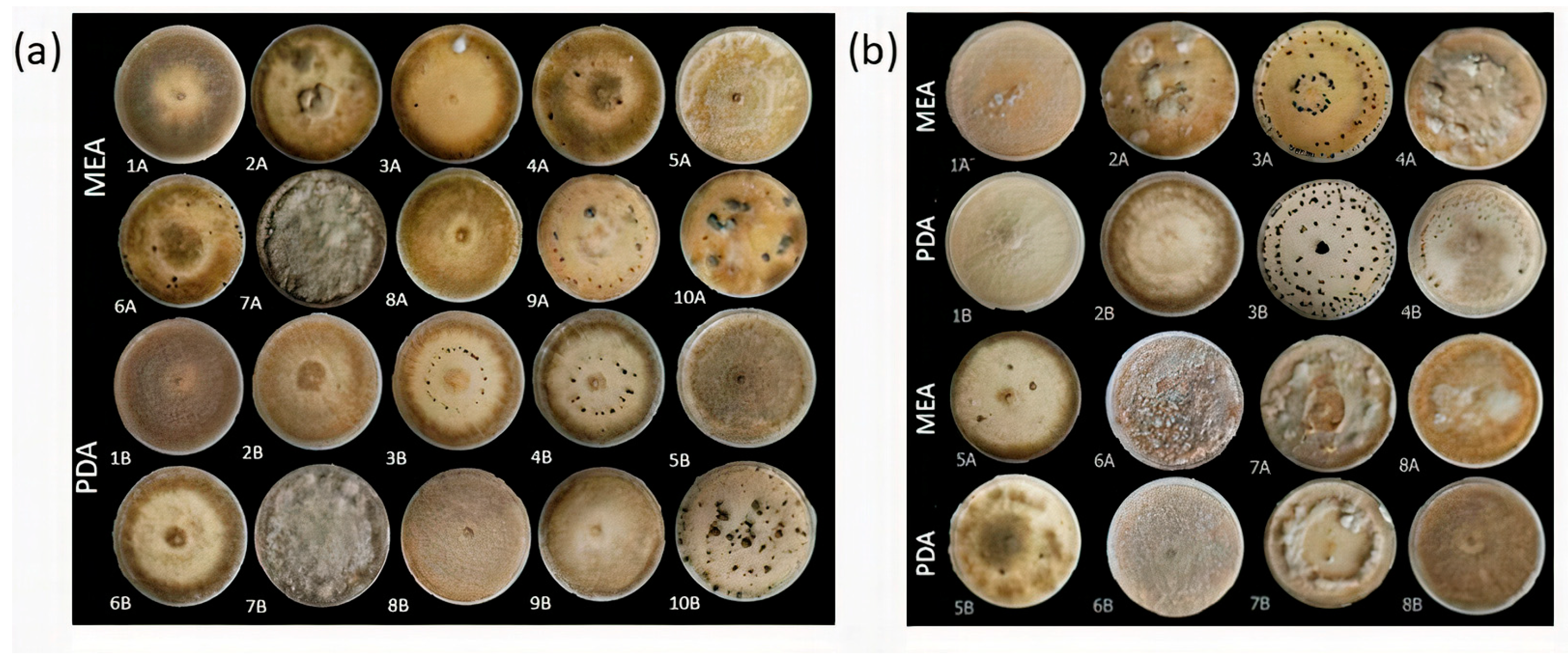
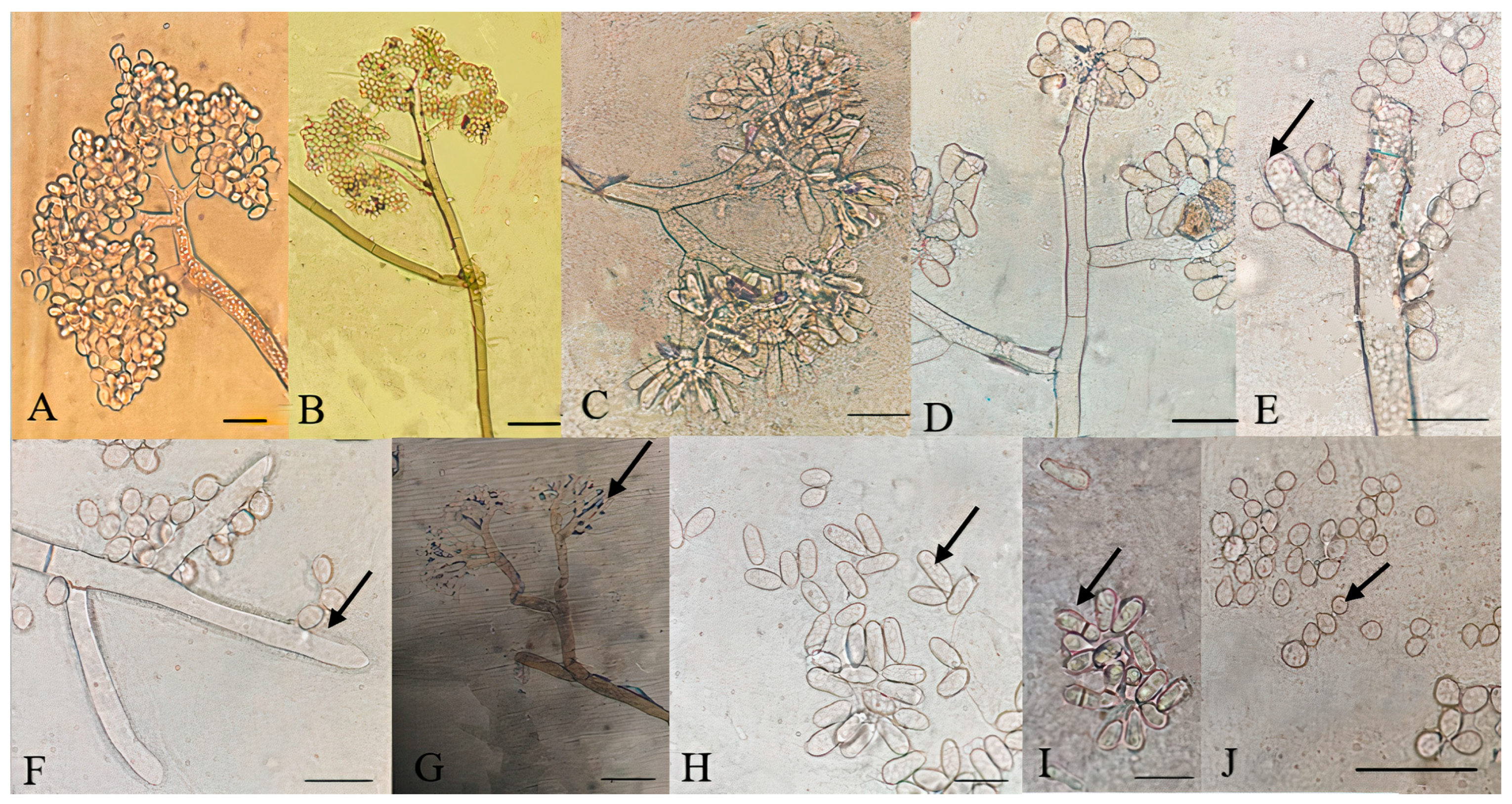
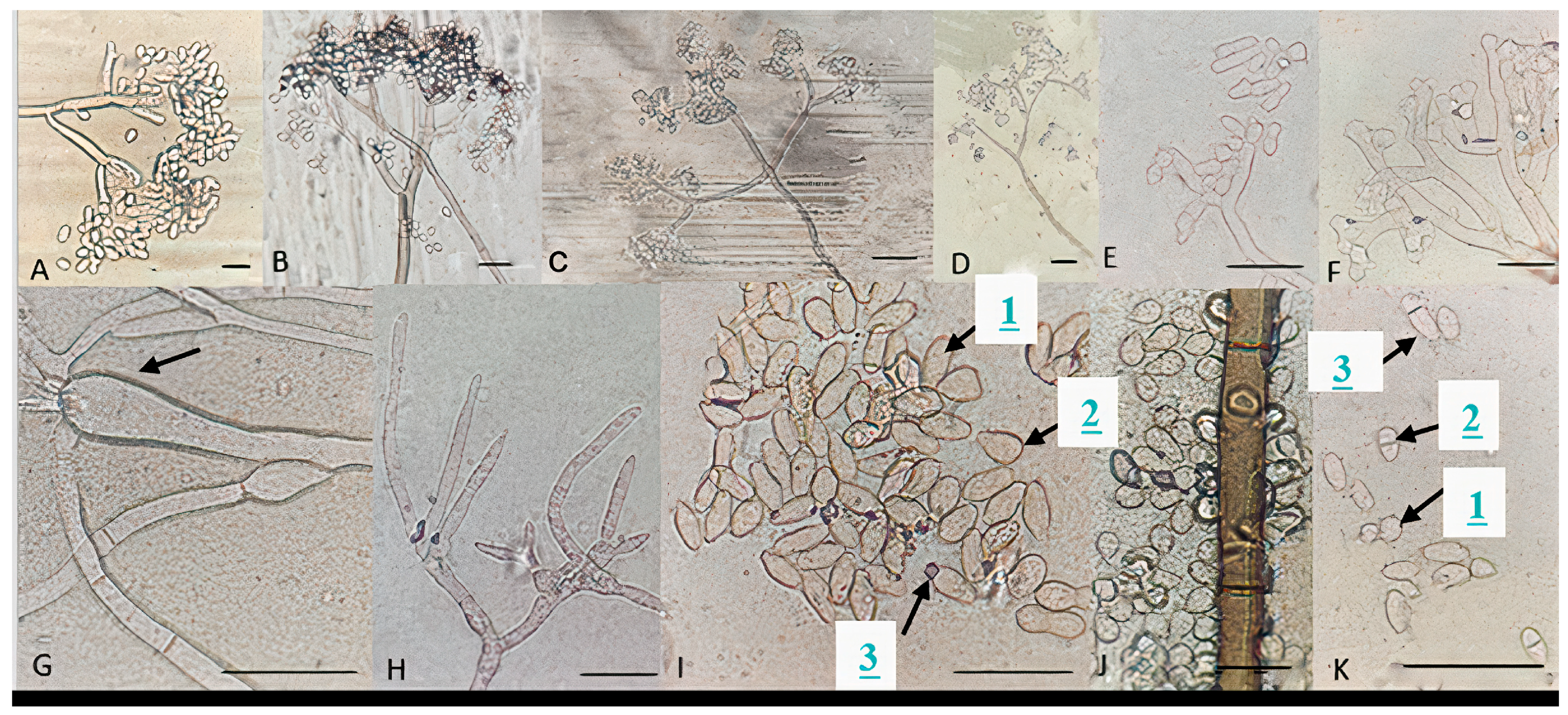
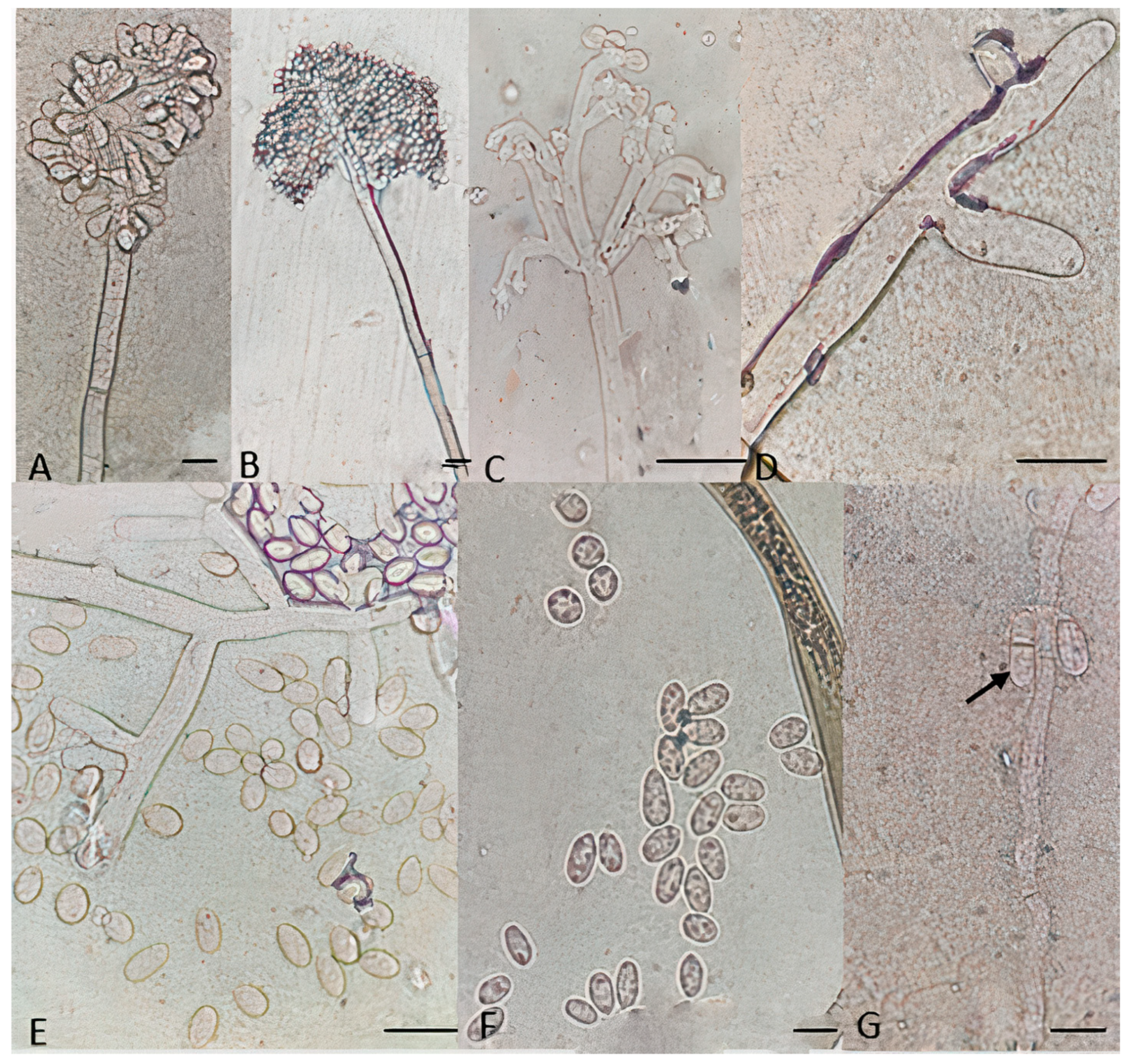

| Host | Population | Origin of Transplant | Province | City | Sampling Time | Growing System | Cultivar |
|---|---|---|---|---|---|---|---|
| Raspberry | P1 | - | Gilan | Kiashahr | Spring 2021 | Jungle | Wild plant |
| P2 | - | Mazandaran | Babol | Spring 2021 | Jungle | Wild plant | |
| Roses | P3 | - | Alborz | Karaj | Autumn 2022 | Garden | Floribundas |
| P4 | - | Markazi | Arack | Autumn 2022 | Greenhouse | Hybrid teas | |
| P5 | - | Isfahan | Isfahan | Autumn 2022 | Greenhouse | Hybrid teas | |
| P6 | - | Hamedan | Hamedan | Autumn 2022 | Greenhouse | Hybrid teas | |
| P7 | - | Isfahan | Kashan | Autumn 2022 | Greenhouse | Hybrid teas | |
| P8 | - | Gilan | Kiashahr | Autumn 2022 | Greenhouse | Hybrid teas | |
| P9 | - | Mazandaran | Noor | Autumn 2022 | Garden | Floribundas | |
| P10 | - | Fars | Shiraz | Autumn 2022 | Greenhouse | Hybrid teas | |
| P17 | - | Khuzestan | Dezful | Autumn 2022 | Greenhouse | Hybrid teas | |
| Strawberry | P11 | Hashtgerd | Alborz | Hashtgerd | Spring 2021 | Greenhouse | Camarosa |
| P12 | Sanandaj | Kurdistan | Chenareh | Spring 2021 | Open field | Camarosa | |
| P13 | Hashtgerd | Gilan | Lahijan | Spring 2021 | Greenhouse | Camarosa | |
| P14 | Hashtgerd | Mazandaran | Behnamir | Spring 2021 | Open field | Sabrina | |
| P15 | Hashtgerd | Kerman | Jiroft | Winter 2022 | Greenhouse | Camarosa | |
| P16 | Orumiyeh | Isfahan | Isfahan | Spring 2021 | Greenhouse | Sabrina/Albion | |
| P18 | Sanandaj | Kurdistan | Kamyaran | Spring 2021 | Greenhouse | Camarosa |
| Gene | Primer | Sequence (5′-3′) | Annealing Temperature | Amplicon Size (bp) | Reference |
|---|---|---|---|---|---|
| Flipper | F300 F1550 | GCACAAAACCTACAGAAGA ATTCGTTTCTTGGACTGTA | 60 °C | 1250 | [23] |
| Boty | B1830 B2800 | ATAAAGAAGCAACCGGATGG AGTCTATCGGGTCCATCCTT | 60 °C | 970 | |
| cytb | Cytb.139 Cytb.872 | ACCGAATGGTGGGATCAATA ATGCCCTCAAAAGGGGATAG | 55 °C | 734 | [15] |
| Bc-hch | 262 520L | AAGCCCTTCGATGTCTTGGA ACGGATTCCGAACTAAGTAA | 55 °C | 1171 | [25] |
| mrr1 | Mrr1-spez-F Mrr1-spez-R | TATCGGTCTTGCAGTCCGC TTCCGTACCCCGATCTTCGGAA | 51 °C | 144–165 | [21] |
| rpb2 | RPB2for+ RPB2rev+ | GATGATCGTGATCATTTCGG CCCATAGCTTGCTTACCCAT | 51 °C | 1184 | [16] |
| hsp60 | HSP60for+ HSP60rev+ | CAACAATTGAGATTTGCCCACAAG GATGGATCCAGTGGTACCGAGCAT | 51 °C | 981 | |
| g3pdh | G3PDHfor+ G3PDHrev+ | ATTGACATCGTCGCTGTCAACGA ACCCCACTCGTTGTCGTACCA | 64 °C | 876 | |
| nep2 | NEP2(−200)for NEP2(+1147)rev | GAACTTTGAATAGTGGGCAGTTGGG GAGTTTCAGGTATATTCGTTTGGTGGA | 51 °C | 1347 | [17] |
| NEP2forE NEP2revE | gtgactgtaaaacgacggccagtTCATCATGGTTGCCTTCTCAAGAT gtgaccaggaaacagctatgaccAAGTAGCAGCTGCAAGATTGTTTG | 51 °C | 845 |
| Selected Isolate | Haplotype | Fungicide Response a | TEs b | mrr1 c | Bc-hch d | cytb e |
|---|---|---|---|---|---|---|
| P18-13 | H1 | SDHIR APR QoIS FenHR FLuHR | B+F+ | W | G2 | T1 |
| P18-6 | H2 | SDHIR APS QoIS FenHR FLuLR | B+F+ | W | G2 | T1 |
| P11-33 | H3 | SDHIR APR QoIS FenHR FLuLR | B+F+ | W | G2 | T1 |
| P11-14 | H4 | SDHIR APS QoIR FenHR FLuS | B+F− | W | G2 | T2 |
| P18-4 | H5 | SDHIR APS QoIR FenHR FLuS | B−F+ | W | G2 | T2 |
| P18-45 | H6 | SDHIS APS QoIS FenLR FluHR | B+F− | W | G2 | T1 |
| P15-21 | H7 | SDHIS APS QoIS FenLR FLuLR | B+F− | W | G2 | T1 |
| P18-14 | H8 | SDHIS APS QoIS FenLR FLuLR | B+F+ | W | G2 | T1 |
| P15-36 | H9 | SDHIS APR QoIS FenLR FLuLR | B+F− | W | G2 | T1 |
| P16-17 | H10 | SDHIS APR QoIS FenLR FLuLR | B+F+ | W | G2 | T1 |
| P6-9 | H11 | SDHIR APR QoIS FenLR FLuLR | B+F− | W | G2 | T1 |
| P5-9 | H12 | SDHIR APR QoIS FenLR FLuS | B+F+ | W | G2 | T1 |
| P12-24 | H13 | SDHIR APS QoIR FenLR FLuS | B+F− | W | G2 | T2 |
| P15-2 | H14 | SDHIS APS QoIS FenS FLulR | B+F− | W | G2 | T1 |
| P10-8 | H15 | SDHIS APS QoIR FenS FLulR | B+F+ | W | G2 | T2 |
| P10-1 | H16 | SDHIS APR QoIS FenS FLulR | B+F− | W | G2 | T1 |
| P14-2 | H17 | SDHIR APS QoIS FenS FLulR | B−F+ | W | G1 | T1 |
| P4-5 | H18 | SDHIR APS QoIR FenS FLulR | B+F− | W | G2 | T2 |
| P14-5 | H19 | SDHIR APR QoIR FenS FLulR | B+F− | W | G2 | T2 |
| P15-7 | H20 | SDHIS APS QoIS FenS FLuS | B+F− | W | G2 | T1 |
| P11-4 | H21 | SDHIR APR QoIR FenS FLulR | B+F+ | W | G2 | T2 |
| P18-44 | H22 | SDHIS APS QoIS FenS FLuS | B+F+ | W | G2 | T1 |
| P13-8 | H23 | SDHIS APS QoIS FenS FLuS | B−F− | W | G2 | T1 |
| P3-1 | H24 | SDHIS APS QoIR FenS FLuS | B+F− | W | G2 | T2 |
| P16-15 | H25 | SDHIS APS QoIR FenS FLuS | B+F+ | W | G2 | T2 |
| P11-16 | H26 | SDHIS APS QoIR FenS FLuS | B−F+ | W | G2 | T2 |
| P18-49 | H27 | SDHIS APS QoIR FenS FLuS | B−F− | W | G2 | T2 |
| P1-2 | H28 | SDHIS APR QoIS FenS FLuS | B+F− | W | G2 | T1 |
| P18-22 | H29 | SDHIS APR QoIS FenS FLuS | B+F+ | W | G2 | T1 |
| P11-10 | H30 | SDHIS APR QoIS FenS FLuS | B−F+ | W | G2 | T1 |
| P14-22 | H31 | SDHIR APS QoIS FenS FLuS | B+F− | W | G2 | T1 |
| P12-14 | H32 | SDHIS APR QoIR FenS FLuS | B+F+ | W | G2 | T2 |
| P18-36 | H33 | SDHIR APR QoIS FenS FLuS | B+F+ | W | G2 | T1 |
| P8-3 | H34 | SDHIR APR QoIS FenS FLuS | B−F+ | W | G2 | T1 |
| P6-11 | H35 | SDHIR APS QoIR FenS FLuS | B+F− | W | G2 | T2 |
| P11-8 | H36 | SDHIR APS QoIR FenS FLuS | B+F+ | W | G2 | T2 |
| P3-8 | H37 | SDHIR APS QoIR FenS FLuS | B−F+ | W | G2 | T2 |
| P17-2 | H38 | SDHIR APR QoIR FenS FLuS | B+F− | W | G2 | T2 |
| P4-4 | H39 | SDHIR APR QoIR FenS FLuS | B−F+ | W | G2 | T2 |
| P16-31 | H40 | SDHIR APR QoIR FenHR FLuLR | B+F+ | W | G2 | T2 |
| P13-5 | H41 | SDHIR APR QoIR FenHR FLuLR | B−F+ | W | G2 | T2 |
| P18-9 | H42 | SDHIR APR QoIR FenHR FLuS | B+F+ | W | G2 | T2 |
| P8-9 | H43 | SDHIR APR QoIR FenHR FLuS | B−F+ | W | G2 | T2 |
| P17-10 | H44 | SDHIR APS QoIR FenHR FLuLR | B+F+ | W | G2 | T2 |
| P16-26 | H45 | SDHIS APR QoIR FenLR FLuLR | B+F+ | W | G2 | T1 |
| P8-6 | H46 | SDHIR APS QoIS FenHR FLuS | B−F+ | W | G2 | T1 |
| P18-55 | H47 | SDHIS APR QoIR FenLR FLuLR | B+F+ | W | G2 | T2 |
| P2-1 | H48 | SDHIS APR QoIR FenHR FLuS | B+F+ | W | G2 | T2 |
| P15-26 | H49 | SDHIS APR QoIS FenLR FLuS | B+F+ | W | G2 | T1 |
| P16-19 | H50 | SDHIS APS QoIR FenLR FLuLR | B+F− | W | G2 | T2 |
| P13-15 | H51 | SDHIS APS QoIR FenLR FLuLR | B−F+ | W | G2 | T2 |
| P12-3 | H52 | SDHIS APS QoIR FenLR FLuLR | B−F− | W | G2 | T2 |
| P14-27 | H53 | SDHIS APS QoIR FenLR FLuS | B+F+ | W | G2 | T2 |
| P18-33 | H54 | SDHIS APS QoIR FenLR FLuS | B−F+ | W | G2 | T2 |
| P11-17 | H55 | SDHIS APS QoIR FenLR FLuS | B+F+ | W | G2 | T1 |
| P2-2 | H56 | SDHIS APS QoIS FenHR FluHR | B−F+ | W | G2 | T1 |
| P18-11 | H57 | SDHIS APS QoIS FenLR FLuS | B+F− | W | G2 | T1 |
| P15-16 | H58 | SDHIS APS QoIS FenLR FLuS | B−F+ | W | G2 | T1 |
| P12-28 | H59 | SDHIS APS QoIS FenS FLuS | B+F+ | S | G2 | T1 |
| P16-24 | H60 | SDHIS APS QoIS FenHR FLuS | B−F+ | S | G2 | T1 |
| Isolate | Species | Origin | Accession Number | ||||
|---|---|---|---|---|---|---|---|
| Host | Province | rpb2 | g3pdh | hsp60 | nep2 | ||
| P14-2 | Botrytis sinoviticola | Strawberry | Mazandaran | OR962124 | OR962092 | OR962108 | na |
| P18-33 | Botrytis cinerea | Strawberry | Kurdistan | OR962134 | OR962102 | OR962118 | OR962149 |
| P18-13 | Botrytis cinerea | Strawberry | Kurdistan | OR962130 | OR962098 | OR962114 | OR962145 |
| P17-2 | Botrytis cinerea | Roses | Khuzestan | OR962138 | OR962106 | OR962122 | OR962152 |
| P14-27 | Botrytis cinerea | Strawberry | Mazandaran | OR962135 | OR962103 | OR962119 | OR962150 |
| P16-15 | Botrytis cinerea | Strawberry | Isfahan | OR962131 | OR962099 | OR962115 | OR962146 |
| P15-7 | Botrytis cinerea | Strawberry | Kerman | OR962128 | OR962096 | OR962112 | OR962143 |
| P8-3 | Botrytis cinerea | Roses | Gilan | OR962126 | OR962094 | OR962110 | OR962141 |
| P6-11 | Botrytis cinerea | Roses | Hamedan | OR962137 | OR962105 | OR962121 | OR962151 |
| P10-8 | Botrytis cinerea | Roses | Fars | OR962123 | OR962091 | OR962107 | OR962139 |
| P15-16 | Botrytis cinerea | Strawberry | Kerman | OR962129 | OR962097 | OR962113 | OR962144 |
| P18-55 | Botrytis prunorum | Strawberry | Kurdistan | OR962127 | OR962095 | OR962111 | OR962142 |
| P18-22 | Botrytis prunorum | Strawberry | Kurdistan | OR962125 | OR962093 | OR962109 | OR962140 |
| P18-45 | Botrytis prunorum | Strawberry | Kurdistan | OR962133 | OR962101 | OR962117 | OR962148 |
| P16-19 | Botrytis prunorum | Strawberry | Isfahan | OR962132 | OR962100 | OR962116 | OR962147 |
| P8-9 | Botrytis prunorum | Roses | Gilan | OR962136 | OR962104 | OR962120 | na |
Disclaimer/Publisher’s Note: The statements, opinions and data contained in all publications are solely those of the individual author(s) and contributor(s) and not of MDPI and/or the editor(s). MDPI and/or the editor(s) disclaim responsibility for any injury to people or property resulting from any ideas, methods, instructions or products referred to in the content. |
© 2024 by the authors. Licensee MDPI, Basel, Switzerland. This article is an open access article distributed under the terms and conditions of the Creative Commons Attribution (CC BY) license (https://creativecommons.org/licenses/by/4.0/).
Share and Cite
Fekrikohan, S.; Sharifnabi, B.; Javan-Nikkhah, M.; Pollastro, S.; Faretra, F.; De Miccolis Angelini, R.M. Genetic and Phenotypic Characterization of Botrytis Populations from Economic and Wild Host Plants in Iran. J. Fungi 2024, 10, 764. https://doi.org/10.3390/jof10110764
Fekrikohan S, Sharifnabi B, Javan-Nikkhah M, Pollastro S, Faretra F, De Miccolis Angelini RM. Genetic and Phenotypic Characterization of Botrytis Populations from Economic and Wild Host Plants in Iran. Journal of Fungi. 2024; 10(11):764. https://doi.org/10.3390/jof10110764
Chicago/Turabian StyleFekrikohan, Sepideh, Bahram Sharifnabi, Mohammad Javan-Nikkhah, Stefania Pollastro, Francesco Faretra, and Rita Milvia De Miccolis Angelini. 2024. "Genetic and Phenotypic Characterization of Botrytis Populations from Economic and Wild Host Plants in Iran" Journal of Fungi 10, no. 11: 764. https://doi.org/10.3390/jof10110764
APA StyleFekrikohan, S., Sharifnabi, B., Javan-Nikkhah, M., Pollastro, S., Faretra, F., & De Miccolis Angelini, R. M. (2024). Genetic and Phenotypic Characterization of Botrytis Populations from Economic and Wild Host Plants in Iran. Journal of Fungi, 10(11), 764. https://doi.org/10.3390/jof10110764






